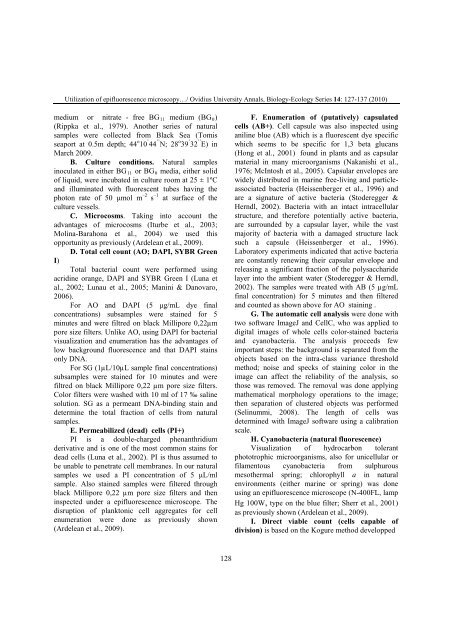VOLUM OMAGIAL - Facultatea de Ştiinţe ale Naturii şi Ştiinţe Agricole
VOLUM OMAGIAL - Facultatea de Ştiinţe ale Naturii şi Ştiinţe Agricole
VOLUM OMAGIAL - Facultatea de Ştiinţe ale Naturii şi Ştiinţe Agricole
You also want an ePaper? Increase the reach of your titles
YUMPU automatically turns print PDFs into web optimized ePapers that Google loves.
Utilization of epifluorescence microscopy…/ Ovidius University Annals, Biology-Ecology Series 14: 127-137 (2010)<br />
medium or nitrate - free BG11 medium (BG0)<br />
(Rippka et al., 1979). Another series of natural<br />
samples were collected from Black Sea (Tomis<br />
seaport at 0.5m <strong>de</strong>pth; 44 o 10 ’ 44 ’’ N; 28 o 39 ’ 32 ’’ E) in<br />
March 2009.<br />
B. Culture conditions. Natural samples<br />
inoculated in either BG11 or BG0 media, either solid<br />
of liquid, were incubated in culture room at 25 ± 1ºC<br />
and illuminated with fluorescent tubes having the<br />
photon rate of 50 μmol m –2 s –1 at surface of the<br />
culture vessels.<br />
C. Microcosms. Taking into account the<br />
advantages of microcosms (Iturbe et al., 2003;<br />
Molina-Barahona et al., 2004) we used this<br />
opportunity as previously (Ar<strong>de</strong>lean et al., 2009).<br />
D. Total cell count (AO; DAPI, SYBR Green<br />
I)<br />
Total bacterial count were performed using<br />
acridine orange, DAPI and SYBR Green I (Luna et<br />
al., 2002; Lunau et al., 2005; Manini & Danovaro,<br />
2006).<br />
For AO and DAPI (5 μg/mL dye final<br />
concentrations) subsamples were stained for 5<br />
minutes and were filtred on black Millipore 0,22µm<br />
pore size filters. Unlike AO, using DAPI for bacterial<br />
visualization and enumeration has the advantages of<br />
low background fluorescence and that DAPI stains<br />
only DNA.<br />
For SG (1µL/10µL sample final concentrations)<br />
subsamples were stained for 10 minutes and were<br />
filtred on black Millipore 0,22 µm pore size filters.<br />
Color filters were washed with 10 ml of 17 ‰ saline<br />
solution. SG as a permeant DNA-binding stain and<br />
<strong>de</strong>termine the total fraction of cells from natural<br />
samples.<br />
E. Permeabilized (<strong>de</strong>ad) cells (PI+)<br />
PI is a double-charged phenanthridium<br />
<strong>de</strong>rivative and is one of the most common stains for<br />
<strong>de</strong>ad cells (Luna et al., 2002). PI is thus assumed to<br />
be unable to penetrate cell membranes. In our natural<br />
samples we used a PI concentration of 5 μL/ml<br />
sample. Also stained samples were filtered through<br />
black Millipore 0,22 µm pore size filters and then<br />
inspected un<strong>de</strong>r a epifluorescence microscope. The<br />
disruption of planktonic cell aggregates for cell<br />
enumeration were done as previously shown<br />
(Ar<strong>de</strong>lean et al., 2009).<br />
128<br />
F. Enumeration of (putatively) capsulated<br />
cells (AB+). Cell capsule was also inspected using<br />
aniline blue (AB) which is a fluorescent dye specific<br />
which seems to be specific for 1,3 beta glucans<br />
(Hong et al., 2001) found in plants and as capsular<br />
material in many microorganisms (Nakanishi et al.,<br />
1976; McIntosh et al., 2005). Capsular envelopes are<br />
wi<strong>de</strong>ly distributed in marine free-living and particleassociated<br />
bacteria (Heissenberger et al., 1996) and<br />
are a signature of active bacteria (Sto<strong>de</strong>regger &<br />
Herndl, 2002). Bacteria with an intact intracellular<br />
structure, and therefore potentially active bacteria,<br />
are surroun<strong>de</strong>d by a capsular layer, while the vast<br />
majority of bacteria with a damaged structure lack<br />
such a capsule (Heissenberger et al., 1996).<br />
Laboratory experiments indicated that active bacteria<br />
are constantly renewing their capsular envelope and<br />
releasing a significant fraction of the polysacchari<strong>de</strong><br />
layer into the ambient water (Sto<strong>de</strong>regger & Herndl,<br />
2002). The samples were treated with AB (5 µg/mL<br />
final concentration) for 5 minutes and then filtered<br />
and counted as shown above for AO staining .<br />
G. The automatic cell analysis were done with<br />
two software ImageJ and CellC, who was applied to<br />
digital images of whole cells color-stained bacteria<br />
and cyanobacteria. The analysis proceeds few<br />
important steps: the background is separated from the<br />
objects based on the intra-class variance threshold<br />
method; noise and specks of staining color in the<br />
image can affect the reliability of the analysis, so<br />
those was removed. The removal was done applying<br />
mathematical morphology operations to the image;<br />
then separation of clustered objects was performed<br />
(Selinummi, 2008). The length of cells was<br />
<strong>de</strong>termined with ImageJ software using a calibration<br />
sc<strong>ale</strong>.<br />
H. Cyanobacteria (natural fluorescence)<br />
Visualization of hydrocarbon tolerant<br />
phototrophic microorganisms, also for unicellular or<br />
filamentous cyanobacteria from sulphurous<br />
mesothermal spring; chlorophyll a in natural<br />
environments (either marine or spring) was done<br />
using an epifluorescence microscope (N-400FL, lamp<br />
Hg 100W, type on the blue filter; Sherr et al., 2001)<br />
as previously shown (Ar<strong>de</strong>lean et al., 2009).<br />
I. Direct viable count (cells capable of<br />
division) is based on the Kogure method <strong>de</strong>velopped





